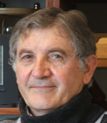 The Alajos Kálmán Prize preserves the memory of the late Alajos Kálmán, an eminent scientist in the field of chemical crystallography. The Prize is established by the Hungarian Chemical Society and is endorsed by European Crystallographic Association (ECA). This year the prize goes to Professor Luigi Nassimbeni from Cape Town University, South-Africa.
The Alajos Kálmán Prize preserves the memory of the late Alajos Kálmán, an eminent scientist in the field of chemical crystallography. The Prize is established by the Hungarian Chemical Society and is endorsed by European Crystallographic Association (ECA). This year the prize goes to Professor Luigi Nassimbeni from Cape Town University, South-Africa.
Luigi Nassimbeni has played a leading role in the chemical sciences in South Africa for more than three decades. Even after his formal retirement, he has continued to be an active researcher and supervisor of PhD students, and has made notable contributions to crystallography within South Africa and abroad over the past decade.
The scope of his research is broad but is always rooted in crystallographic techniques and results. Initially working on inorganic compounds he expanded his interests into the new field of supramolecular chemistry in the 1990s, and over the past 20 years he has worked extensively on the physical chemistry of inclusion compounds. In all cases, crystallographic techniques (single-crystal and powder diffraction) form the foundation for the study of structure-property relationships in a wide range of materials. He has contributed significantly to :
- the development of techniques for studying the thermodynamics and kinetics of guest desorption from inclusion compounds by thermal analysis and vapour pressure measurement (including the construction of novel instruments where necessary)
- the development of criteria for host selection to achieve separation of structurally close isomers.
- the knowledge of hydrogen- vs halogen-bonding in co-crystals and their influence on selectivity for separation of isomers.
- the understanding of the crystallisation temperature as a mechanism for controlling stoichiometry in host-guest compounds.
As a crystallographer, Luigi Nassimbeni has had a profound impact in the growth of the discipline within South Africa and across Africa. In the 1970s he was one of only a handful of crystallographers in South Africa. After a period of sabbatical leave at the University of Cambridge, UK, where he worked with Dr Olga Kennard, he was one of the first to teach other crystallographers how to use the then-new technique of direct methods to solve crystal structures. Aside from his scientific input, he was active in promoting and growing the science of crystallography. Nationally he maintained a high profile as president of the South African Crystallographic Society (1986-1991 and 1994-1997) and as chairman of the International Union of Crystallography’s SA National committee (1998-2000), and still serves as a committee member on both bodies. He has represented South Africa as a delegate to the General Assembly of the IUCr at five congresses between 1981 and 1999, and was instrumental in 1987 in having South Africa’s representation on this body increased from one member to two, in recognition of the growth in crystallography in this country. Luigi Nassimbeni has also been an active participant in European Crystallographic Association activities over many years.
